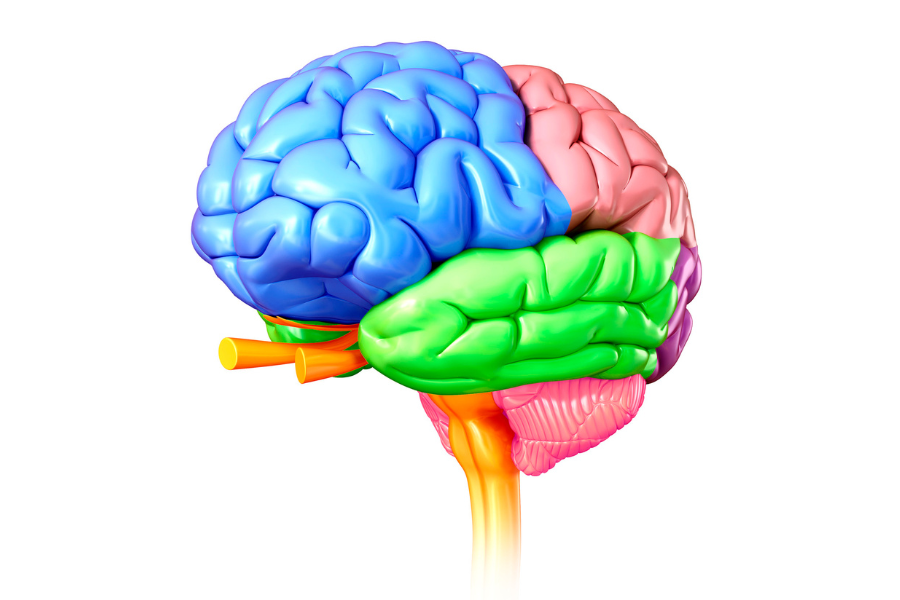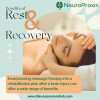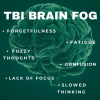The temporal lobe is largely responsible for creating and preserving both conscious and long-term memory. It plays a role in visual and sound processing and is crucial for both object recognition and language recognition. For example, when we hear sounds, the temporal lobe will make useful information out of it, allowing us to understand a variety of words and sounds that become stored as memories. It also processes and allows you to understand what you are seeing and the complex aspects of visual information such as recognizing faces (e.g., family members or celebrity) or identifying objects. Additionally, it contributes to our emotional and behavioral responses.
The temporal lobe plays an important role in expressive and receptive language (e.g., written or spoken). Expressive language is the ability to express your thoughts. Examples include speaking with your friends, writing a letter, or any other form of communication. A specialized area called Wernicke’s area, is located on the left temporal lobe and is responsible for understanding speech, also known as receptive language. Receptive language is understanding information you are receiving. For example, understanding the verbal directions you are given from a teacher.
It also processes different types of memories such as long-term memory, which includes a special type of memory called declarative memory, auditory, and visual, and a role in olfactory memory. Below is a list of the different types of memories and examples:
| Type of Memory | Definition | Examples |
| Long Term Memory
|
A memory that becomes stored for a long period of time and is easy to retrieve (e.g., your phone number) | Your address
Your sibling’s birthday |
| Episodic Memory
(This is a type of long term memory) |
Memories based on personal facts and events. | Remember your high school graduation year
Remembering your best friend was in high school |
| Semantic Memory (This is a type of long term memory) | Recalling learned information such as general events and facts. | Remembering that Christmas day is on December 25th. |
| Visual Memory | Recalling information you have seen. | Copying letters or numbers
Remembering phone numbers |
| Auditory Memory | Recalling information you have heard. | Remembering a conversation |
| Olfactory Memory | Recalling a scent you have smelled.
Closely linked to our emotional memories |
Remembering a scent of a pine tree
A pine tree might also make a person remember a Christmas memory |
The temporal lobe also plays a role in processing our emotional and motivational behaviors. However, emotional and motivational behaviors are part of a more specialized structure of our brain called the limbic system located beneath the temporal lobe.
Lesions to the temporal lobe includes the following:
| Diagnosis / Deficit | Definition | Strategies |
| Agnosia | Inability to recognize information such as objects or faces | Performing tasks in a predictable environment
(e.g., placing clothing in the same location every morning)
Follow a consistent routine as much as possible
Adapt the environment with the most commonly used items in sight. Declutter irrelevant items
Look for clues, or differences in faces, such as a birthmark |
| Long term memory | A memory that becomes stored for a long period of time and is easy to retrieve (e.g., your phone number) | Using a desk calendar or phone calendar (make it a habit to check it every morning and glance at it throughout the day)
Setting reminders on your phone.
Setting alarms on your phone.
Writing notes on post it notes and please them on visible areas such as your laptop
Using a dry erase board in room or on your refrigerator for important information
|
| Declarative memory
(Examples very similar to long term memory) |
Memories based on facts and events | |
| Semantic memory | A form of long-term memory to recall information we have learned throughout our lives. Plays a vital role in language. Includes remembering names, numbers, words, and general facts | |
| Attention | Limiting visual distractions background noise in the environment
Taking breaks often to help with attention span |
|
| Aggressive behaviors | Verbal, characterized by anger or physical aggression | Minimize confusion
(Use short simple words)
Utilizing coping strategies (Deep breathing exercises meditation. Videos can be found on online such as Youtube)
Journaling to discover triggers before experiencing anger
Practicing counting down from 10 before reacting
Walking away from the situation
Listening to music to increase mood
Aroma therapy (such as lavender oil) or weighted blankets to decrease any anxiety
Keep the environment safe! |
| Hallucinations | A sensory experience in which a person can see, hear, smell, taste, or feel something that is not there | Engage in deep breathing exercises and mindfulness techniques as soon as the hallucinations begin
Making sure you are taking medication as prescribed
Abstaining from alcohol or substances
Cognitive behavioral therapy (CBT) can help change the way an individual responds to a hallucination
Getting plenty of sleep |
References:
Binder J. R. (2015). The Wernicke area: Modern evidence and a reinterpretation. Neurology, 85(24), 2170–2175. https://doi.org/10.1212/WNL.0000000000002219
Jeneson, A., & Squire, L. R. (2011). Working memory, long-term memory, and medial temporal lobe function. Learning & memory (Cold Spring Harbor, N.Y.), 19(1), 15–25. https://doi.org/10.1101/lm.024018.111
Kalat, J. W. (2017). Biological Psychology. Cengage
Purves D, Augustine GJ, Fitzpatrick D, et al., editors. Neuroscience. 2nd edition. Sunderland (MA): Sinauer Associates; 2001. Lesions of the Temporal Association Cortex: Deficits of Recognition. Available from: https://www.ncbi.nlm.nih.gov/books/NBK11131/
https://agnosia-ot.weebly.com/interventions.html
Rao, V., Rosenberg, P., Bertrand, M., Salehinia, S., Spiro, J., Vaishnavi, S., Rastogi, P., Noll, K., Schretlen, D. J., Brandt, J., Cornwell, E., Makley, M., & Miles, Q. S. (2009). Aggression after traumatic brain injury: prevalence and correlates. The Journal of neuropsychiatry and clinical neurosciences, 21(4), 420–429. https://doi.org/10.1176/jnp.2009.21.4.420
McCarthy-Jones, S., Hayward, M., Waters, F., & Sommer, I. E. (2016). Editorial: Hallucinations: New Interventions Supporting People with Distressing Voices and/or Visions. Frontiers in psychology, 7, 1418. https://doi.org/10.3389/fpsyg.2016.01418



